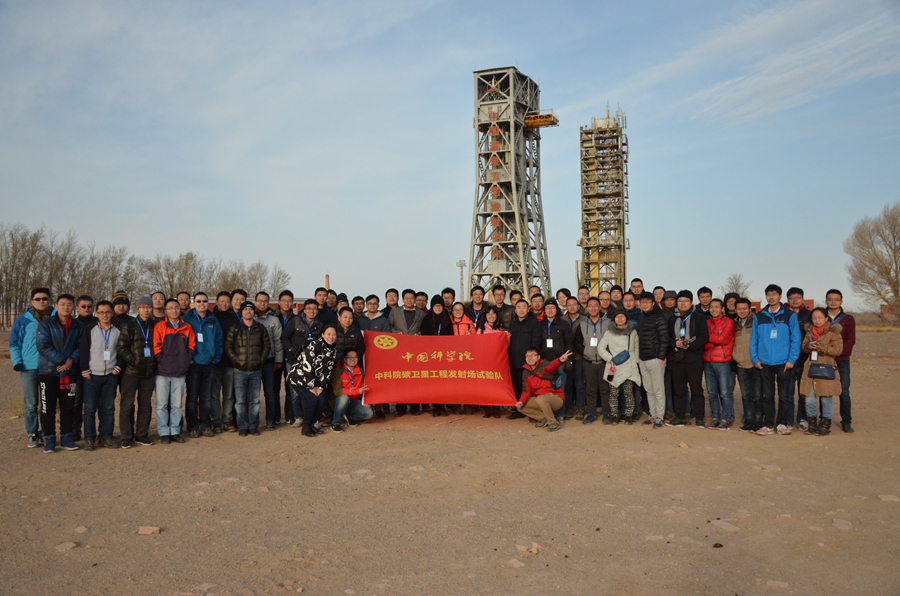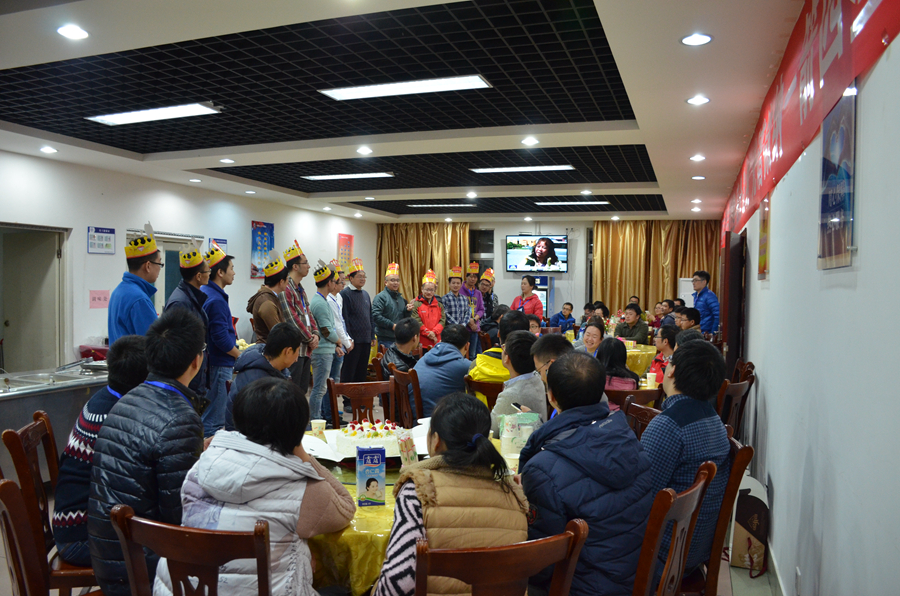
Group Photo of Exoperiment Team

Birthday Party in the Base
2016 is doomed to be unusually in the history of Chinese aviation and the satellite is one of so many “firsts” in the year, which is further to be recorded in the history.
In the early morning of December 22, China launched the first carbon dioxide monitoring satellite (referred to as “TanSat”), which would begin its in-orbit work for 3 years. Every day TanSat will record data lasting for about 10 hours, which will serve as the first-hand data for carbon dioxide monitoring in China. “It is just when Paris Agreement has taken effect officially, so TanSat is a responsible one,” said Xiangli Bin, the vice president of Chinese Academy of Sciences.
The team who created the “responsible” satellite had overtime work several months ago. On Nov. 8th, the satellite developed by Chinese Academy of Sciences micro-satellite Research Institute left the factory in Shanghai and was transported to Jiuquan Satellite Launch Center. In the kick-off meeting, Xiangli Bin sent wishes, “Build up the body and civilize the spirits”, to the research team comprising 125 people at the average age of 31 and expected them to be a new generation of faithful, courageous and capable aviation men who are brave enough to challenge, struggle and never give up.
There are many experienced veterans going through numerous missions in the experiment team, who are united like one person and submit themselves to the direction. Coming towards them, you will find they are unique souls, gather together because of the cause they love and form the unique “micro-satellite spirit”.
Nov. 12th is the second day when the experiment team entered the base. In the working conference, the team leader made propagation and implementation of rules, security and confidentiality to all the members. Afterwards, all the detachments made another intense round of discussion and confirmation of their own working plans and detailed rules for assembly and testing in the launch site in order to lay a solid foundation for the following experiment teams developing the work in all the phases in the launch site.
Nov. 14th is an important day, when TanSat eventually arrived at Jiuquan Launch Base after a week’s journey. In the early morning, all the members of the experiment team headed for the comprehensive test workshop, double checked the security and cleanness on the scene and made full preparation for the arrival the satellite and the following test. In the afternoon, the special train carrying the satellite pulled into the base slowly. According to the previous arrangement, the experiment team finished in an orderly way the unloading and transfer work of the satellite, testing instruments and equipment and living goods under the unified leadership.
The TanSat has a very high measuring accuracy. “In the atmosphere, the density of carbon dioxide is only about 4 in ten thousand. However, as long as the density changes by 1 percent, it will be detected by TanSat. Therefore, we must test it repeatedly to ensure its accuracy”, Zhang Yong, the vice chief designer of TanSat introduced.
On Nov.18th, TanSat passed the power-up test; on Nov.22nd, carbon loading passed the test of optic character; on Nov.25th, the experiment team made the series of tests and TanSat was batten down formally. On Dec.7th, the satellite filling began; on 11th, the underskirt and belt angle of the satellite were installed and connected to the supporting cabin of the rocket. All the briefings from the experiment team base convey the meticulous attitudes and vibrant fighting will in lines.
“TanSat, which was once closely associated with us, is just like the comrade fighting shoulder by shoulder. We only hope it can complete the mission successfully and benefit the people’s livelihood”. Cheng Rui, chief of the model office, seeing the satellite entering the supporting cabin slowly, is filled with reluctance and expectation.
“The launch of TanSat will provide data support for scientific development and enable our country to have the discourse power in the future carbon transaction. In addition, China will share the monitoring data with global researchers”. Yin Zengshan, chief designer of TanSat, felt proud of the young team and the great achievement they got.
2016 is doomed to be unusually in the history of Chinese aviation and the satellite is one of so many “firsts” in the year, which is further to be recorded in the history.
In the early morning of December 22, China launched the first carbon dioxide monitoring satellite (referred to as “TanSat”), which would begin its in-orbit work for 3 years. Every day TanSat will record data lasting for about 10 hours, which will serve as the first-hand data for carbon dioxide monitoring in China. “It is just when Paris Agreement has taken effect officially, so TanSat is a responsible one,” said Xiang Libin, the vice president of Chinese Academy of Sciences.
The team who created the “responsible” satellite had overtime work several months ago. On Nov. 8th, the satellite developed by Chinese Academy of Sciences micro-satellite Research Institute left the factory in Shanghai and was transported to Jiuquan Satellite Launch Center. In the kick-off meeting, Xiang Libin sent wishes, “Build up the body and civilize the spirits”, to the research team comprising 125 people at the average age of 31 and expected them to be a new generation of faithful, courageous and capable aviation men who are brave enough to challenge, struggle and never give up.
There are many experienced veterans going through numerous missions in the experiment team, who are united like one person and submit themselves to the direction. Coming towards them, you will find they are unique souls, gather together because of the cause they love and form the unique “micro-satellite spirit”.
Nov. 12th is the second day when the experiment team entered the base. In the working conference, the team leader made propagation and implementation of rules, security and confidentiality to all the members. Afterwards, all the detachments made another intense round of discussion and confirmation of their own working plans and detailed rules for assembly and testing in the launch site in order to lay a solid foundation for the following experiment teams developing the work in all the phases in the launch site.
Nov. 14th is an important day, when TanSat eventually arrived at Jiuquan Launch Base after a week’s journey. In the early morning, all the members of the experiment team headed for the comprehensive test workshop, double checked the security and cleanness on the scene and made full preparation for the arrival the satellite and the following test. In the afternoon, the special train carrying the satellite pulled into the base slowly. According to the previous arrangement, the experiment team finished in an orderly way the unloading and transfer work of the satellite, testing instruments and equipment and living goods under the unified leadership.
The TanSat has a very high measuring accuracy. “In the atmosphere, the density of carbon dioxide is only about 4 in ten thousand. However, as long as the density changes by 1 percent, it will be detected by TanSat. Therefore, we must test it repeatedly to ensure its accuracy”, Zhang Yong, the vice chief designer of TanSat introduced.
On Nov.18th, TanSat passed the power-up test; on Nov.22nd, carbon loading passed the test of optic character; on Nov.25th, the experiment team made the series of tests and TanSat was batten down formally. On Dec.7th, the satellite filling began; on 11th, the underskirt and belt angle of the satellite were installed and connected to the supporting cabin of the rocket. All the briefings from the experiment team base convey the meticulous attitudes and vibrant fighting will in lines.
“TanSat, which was once closely associated with us, is just like the comrade fighting shoulder by shoulder. We only hope it can complete the mission successfully and benefit the people’s livelihood”. Cheng Rui, chief of the model office, seeing the satellite entering the supporting cabin slowly, is filled with reluctance and expectation.
“The launch of TanSat will provide data support for scientific development and enable our country to have the discourse power in the future carbon transaction. In addition, China will share the monitoring data with global researchers”. Yin Zengshan, chief designer of TanSat, felt proud of the young team and the great achievement they got.

